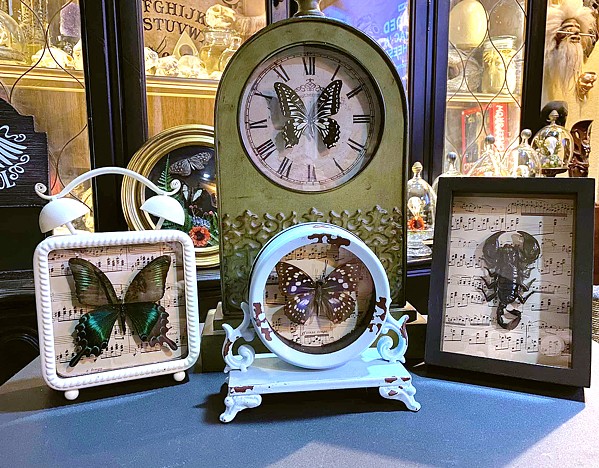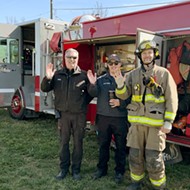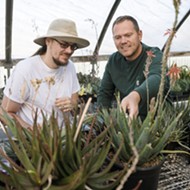[{
"name": "Ad - Medium Rectangle CC01 - 300x250",
"id": "AdMediumRectangleCC01300x250",
"class": "inlineCenter",
"insertPoint": "8",
"component": "2963441",
"requiredCountToDisplay": "12"
},{
"name": "Ad - Medium Rectangle LC01 - 300x250",
"id": "AdMediumRectangleCC01300x250",
"class": "inlineCenter",
"insertPoint": "18",
"component": "2963441",
"requiredCountToDisplay": "22"
},{
"name": "Ad - Medium Rectangle LC09 - 300x250",
"id": "AdMediumRectangleLC09300x250",
"class": "inlineCenter",
"insertPoint": "28",
"component": "3252660",
"requiredCountToDisplay": "32"
}]
On Thursday nights, Higuera Street is packed with various vendors hawking their wares at the Downtown SLO Farmers' Market. Nestled between a jewelry vendor and a booth featuring succulents is one business that sells something genuinely bizarre.
Jars of decorated animal skulls, various preserved animal feet, pinned butterflies, and other creature curios are neatly arranged on a table. These unique creations are the work of Erin Binger, owner of Bizarre Antiques and Oddities.
"I don't kill anything for my art. Most of my stuff comes from exterminators, where, you know, it's their job to kill these things," Binger said. "And so instead of just tossing it into the trash, I give it a second life."
Before she started Bizarre Antiques and Oddities, Binger worked at a funeral home, where she learned how to embalm and preserve things. When the COVID-19 pandemic started, that's when Binger decided to take a leap of faith, quit her job at the funeral home, and take up a new endeavor. Inspiration struck when a friend gifted Binger with a rodent skull two years ago.
"My cat kept messing with it and knocked it off the top of my cabinet and broke it. And so then I was like, OK, you know, I need to put something over this," Binger said. "I put it up a little higher, and it didn't work so I put a wineglass over the top of it, and it just snowballed from there."
Since then, Binger has been turning the dead into works of art, preserving their beauty in glass cloches surrounded by flowers, pinning them in photo frames, or letting their natural beauty shine in a simple glass jar.
"I try to make things differently. You know, try not to make anything the same. Like I don't want it to have that cookie-cutter reproductive [aesthetic]," said Binger, who often sources things to include in her art from antique stores.
"I try to keep the classical side of taxidermy and pinned creatures that they would do 200 years ago," Binger said. "So I try to keep that same classy, Victorian style to my stuff as well as throwing in plastic things like that don't fall apart and rot and decay, so that will literally last the way it is forever."
Aside from getting specimens from exterminators and pet stores, Binger told New Times that sometimes people will donate things for her to use in her art, including deceased pets.
"Occasionally once in a blue moon, I might pick up roadkill, but it's just meh. I don't like stuff that I don't know how long it's been there," Binger said.
Not every animal Binger receives can be useable. While she uses what she can, Binger said that she'll oftentimes discard the guts.
"I have to kind of examine it, see what parts of it I can use or if I can use the whole creature—if it's in good shape, I will essentially embalm the whole creature and put it in a jar," Binger said. "If it's damaged to the skull or damaged to the body, I will use what I can off of it so the littlest amount gets wasted."
The process of transforming corpses into art can take anywhere from a few days to several weeks, depending on whether Binger is mummifying them, dehydrating them, or simply cleaning the skulls and bones. While Binger works on all sorts of critters, both big and small, she said that any poisonous animals and ones suspected to have rabies are off-limits.
"I have animals at home. I have my three dogs, three cats, two chickens, and 10 rabbits," Binger said. "I can't expose them or take a risk of exposing them to anything so I just don't. That's another reason why I don't pick up a lot of roadkill."
Out of all the creatures she works with, snakes are Binger's personal favorite.
"I could never have a live one, just because they creep me out. They bite and sometimes, they're kind of an unpredictable creature," Binger said. "But when they're dead, they're beautiful. I love their skeletons. I love seeing them diaphonized. I love seeing them in a frame. "
Reactions to Binger's art can vary. Binger says most people are fascinated by her creations, but there are some who are apprehensive. Macey Hardridge, owner of Lucky Lucky Studios in SLO became a fan of Binger's art five months ago when her friend purchased a piece of Binger's art. That led Hardridge to purchase pieces of her own—one of a snake skeleton, and another of an open-mouthed alligator skull.
"I think when it comes to artwork in general, a lot of it's subjective, and so it depends on what people like, [and] it if it's not their thing, I think that's totally fine," Hardridge said. "But if you think about it as artwork and also preserving beautiful things, I think that can change the mindset a little bit."
Fast fact
• Get hatchin' with the help of Bell Family Farms, a licensed and local family hatchery that specializes in producing large weekly batches of day-old chicks. Reserve your chicks at bellfamily.farm and pick them up on any Saturday in Paso Robles. Δ
Contact Staff Writer Shwetha Sundarrajan at [email protected].










